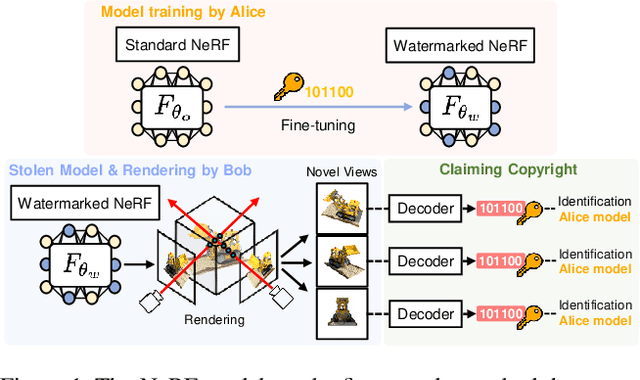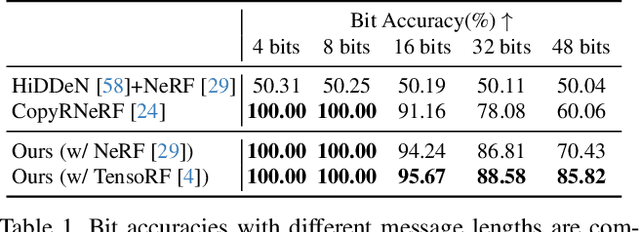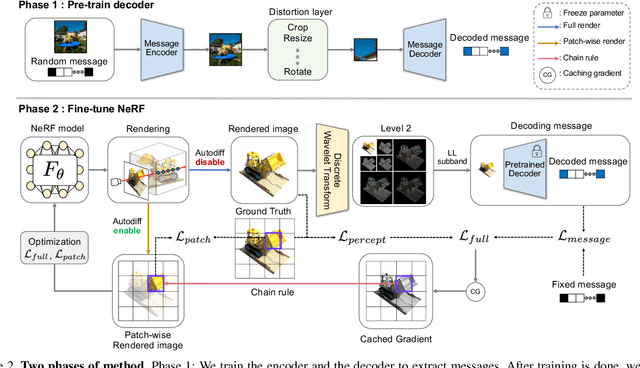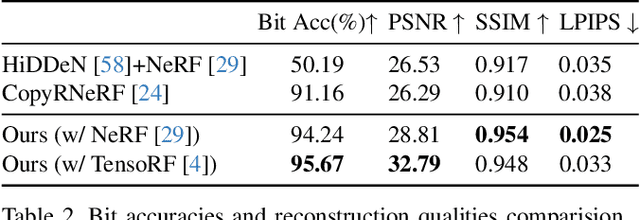Youngdong Jang
CompMarkGS: Robust Watermarking for Compression 3D Gaussian Splatting
Mar 17, 2025Abstract:3D Gaussian Splatting (3DGS) enables rapid differentiable rendering for 3D reconstruction and novel view synthesis, leading to its widespread commercial use. Consequently, copyright protection via watermarking has become critical. However, because 3DGS relies on millions of Gaussians, which require gigabytes of storage, efficient transfer and storage require compression. Existing 3DGS watermarking methods are vulnerable to quantization-based compression, often resulting in the loss of the embedded watermark. To address this challenge, we propose a novel watermarking method that ensures watermark robustness after model compression while maintaining high rendering quality. In detail, we incorporate a quantization distortion layer that simulates compression during training, preserving the watermark under quantization-based compression. Also, we propose a learnable watermark embedding feature that embeds the watermark into the anchor feature, ensuring structural consistency and seamless integration into the 3D scene. Furthermore, we present a frequency-aware anchor growing mechanism to enhance image quality in high-frequency regions by effectively identifying Guassians within these regions. Experimental results confirm that our method preserves the watermark and maintains superior image quality under high compression, validating it as a promising approach for a secure 3DGS model.
LVMark: Robust Watermark for latent video diffusion models
Dec 12, 2024Abstract:Rapid advancements in generative models have made it possible to create hyper-realistic videos. As their applicability increases, their unauthorized use has raised significant concerns, leading to the growing demand for techniques to protect the ownership of the generative model itself. While existing watermarking methods effectively embed watermarks into image-generative models, they fail to account for temporal information, resulting in poor performance when applied to video-generative models. To address this issue, we introduce a novel watermarking method called LVMark, which embeds watermarks into video diffusion models. A key component of LVMark is a selective weight modulation strategy that efficiently embeds watermark messages into the video diffusion model while preserving the quality of the generated videos. To accurately decode messages in the presence of malicious attacks, we design a watermark decoder that leverages spatio-temporal information in the 3D wavelet domain through a cross-attention module. To the best of our knowledge, our approach is the first to highlight the potential of video-generative model watermarking as a valuable tool for enhancing the effectiveness of ownership protection in video-generative models.
WateRF: Robust Watermarks in Radiance Fields for Protection of Copyrights
May 03, 2024



Abstract:The advances in the Neural Radiance Fields (NeRF) research offer extensive applications in diverse domains, but protecting their copyrights has not yet been researched in depth. Recently, NeRF watermarking has been considered one of the pivotal solutions for safely deploying NeRF-based 3D representations. However, existing methods are designed to apply only to implicit or explicit NeRF representations. In this work, we introduce an innovative watermarking method that can be employed in both representations of NeRF. This is achieved by fine-tuning NeRF to embed binary messages in the rendering process. In detail, we propose utilizing the discrete wavelet transform in the NeRF space for watermarking. Furthermore, we adopt a deferred back-propagation technique and introduce a combination with the patch-wise loss to improve rendering quality and bit accuracy with minimum trade-offs. We evaluate our method in three different aspects: capacity, invisibility, and robustness of the embedded watermarks in the 2D-rendered images. Our method achieves state-of-the-art performance with faster training speed over the compared state-of-the-art methods.
 Add to Chrome
Add to Chrome Add to Firefox
Add to Firefox Add to Edge
Add to Edge